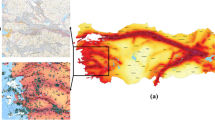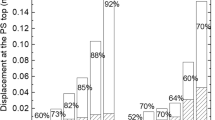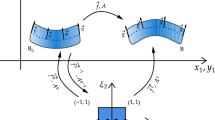Abstract
Post-Earthquake Fire (PEF) on frame structures usually leads to complicated and unpredictable thermal performance of damaged concrete members. In order to determine the structural performance of seismic-damaged Reinforced Concrete (RC) beams under PEF conditions, the RC frame structures are subjected to the shake table test. The test, used in conjunction with other existing seismic hazard data, demonstrates that the main geometric damage forms of RC beams after the earthquake are cracks and concrete spalling. Subsequently, calculating models of PEF RC beams are established in ABAQUS, and then the distribution of thermal field, high-temperature bearing capacity and reduction coefficient of seismic-damaged beams are proposed respectively. From experimental and numerical investigations, It can conclude that (a) the simplified numerical models are proven to accurately determine the fire performance of the damaged RC beams; (b) the thermal performance degradation caused by spalling is more severe than the degradation caused by cracking on PEF RC beams, which demonstrates that spalling takes a more important role than cracking; and (c) the prediction equation of the flexural bearing capacity reduction factor of PEF RC beams is feasible.
Similar content being viewed by others
References
ABAQUS standard/Explicit User’s Manual (2006). Hibbitt, Karlsson and Sorensen, Inc., Version 6.5, USA, pp. 28–34.
ABAQUS User Subroutines Reference Manual (2006). Hibbitt, Karlsson and Sorensen, Inc., Version 6.5, USA. pp. 45–53.
Behnam, B. (2016). Post-earthquake fire analysis in urban structures: Risk management strategies, CRC Press, pp. 10–60, USA.
Behrouz, B. and Hamid, R. (2013). “Performance of reinforced concrete structures subjected to fire following earthquake.” European Journal of Environmental and civil Engineering, Vol. 17, No. 4, pp. 270–292, DOI: 10.1080/19648189.2013.783882.
British Standards Institutions (1990). Structural use of steel-work in building, Report, Part 8: Code of Practice for Fire Resistance Design, London, USA.
Chen, S. W., Li, G. Q., and Xiong, L. Y. (2008). “Advance in research on secondary fire of earthquake.” Journal of Natural Disasters, Vol. 17, No. 5, pp. 120–126, DOI: 10.13577/j.jnd.2008.0520.
Chen, S. C., Tian, X. M., and Yan, W. M. (2011). “A preliminary survey on analysis method of building structures under post-earthquake fire.” Journal of Civil, Architectural & Environmental Engineering, Vol. 33, No. 6, pp. 90–119.
Ervine, A., Gillie, M., Stratford, T. J., and Pankaj, P. (2012). “Thermal propagation through tensile cracks in reinforced concrete.” Journal of Materials in Civil Engineering, Vol. 24, No. 5, pp. 516–522, DOI: 10.1061/(ASCE) MT.1943-5533.0000417.
Eurocode 2 (2004). Design of steel structure (Part 1-2: General rules-structural fire design), Report, BSEN1992-1-2, British Standards Institution, Brussels, UK.
Eurocode 2 (2005). Design of concrete structure (Part 1–2: General rules-structural fire design), Report, BSEN1992-1-2, British Standards Institution, London, UK, pp. 23–28.
Eurocode 4 (2005). Design of composite steel and concrete structures (Part 1–2: General rules-structural fire design), Report, EN1994-1-2, European Committee for Standardization, Brussels, UK, pp. 36–40.
Huang, Z., Liew, R., and Li, W. (2017). “Evaluation of compressive behavior of ultra-lightweight cement composite after elevated temperature exposure.” Construction & Building Materials, Vol. 148, pp. 579–589, DOI: 10.1680/jmacr.15.00497.
Huang, Z., Padmaja, K., Li, S., and Liew, R. (2018). “Mechanical properties and microstructure of ultra-lightweight cement composites with fly ash cenospheres after exposure to high temperatures.” Construction & Building Materials, Vol.164, pp.760–774, DOI: 10.1016/j.conbuildmat.2018.01.009.
ISO 834–1 (1999). Fire-resistance tests -Elements of building construction -Part 1: General requirement. Switzerland: International Organization for Standardization, Report, ISO 834–1, Sweitzerland, pp. 12–15.
Jiang, J. J. and Xu, Z. S. (2005). Disaster prevention and mitigation engineering, China Machine Press, Beijing, China.
Li, Y. Q., Ma, D. Z., and Xu, J. (1991). Construction structure fire prevention design calculation and construction processing, Architecture & Building Press, Beijing, China.
Lie, T. T. and Celikkol, B. (1991). “Method to calculate the fire resistance of circular reinforced concrete columns.” ACI Materials Journal, Vol. 88, No. 1, pp. 84–91.
Lu, Z. D. (1989). Study on fire response of simple supported reinforced concrete beams, Tongji University, Shanghai, China.
Memari, M., Mahmoud, H., and Ellingwood, B. (2014). Post-earthquake fire performance of moment resisting frames with reduced beam section connections.” Journal of Constructional Steel Research, Vol. 103, pp. 215–229, DOI: 10.1016/j.jcsr.2014.09.008.
Miao, J. J. and Chen, N. (2013). “Experimental research and numerical simulation on fire resistance performance of RC beams with damages caused by service loading.” Journal of Building Structures, Vol. 34, No. 3, pp. 1–11, DOI: 10.14006/j.jzjgxb.2013.03.001.
Ronagh, H. R. and Behnam, B. (2012). “Investigating the effect of prior damage on the post-earthquake fire resistance of reinforced concrete portal frames.” International Journal of Concrete Structures and Materials, Vol. 6, No. 4, pp. 209–220, DOI: 10.1007/s40069-012-0025-9.
Shao, L. Q., Li, H., and Chen, W. Y. (2009). “Investigation and analysis on damages to reinforced concrete frame and bent structures by 5.12 Wenchuan earthquake.” Industrial Construction, Vol. 39, No. 1, pp. 20–24, DOI: 10.13204/j.gyjz2009.01.005.
Sharma, U. K., Bhargava, P., Singh, B., Torero, J., and Pankaj, P. (2012). “Full–scale testing of a damaged reinforced concrete frame in fire.” Proceedings of The Institution of Civil Engineers-structures and Buildings, ICS, London, UK, Vol. 165, No. 7, pp. 335–346, DOI: 10.1680/stbu.11.00031.
Shi, X. D., Tom, T. H., and Guo, Z. H. (2002). “Effect of force -temperature paths on behaviors of reinforced concrete flexural members.” Journal of Structural Engineering, Vol. 108, No. 3, pp. 365–373, DOI: 10.1061/(ASCE)0733-9445(2002)128:3(365).
Sun, J. F., Shi, X. D., and Guo, Z. H. (2002). “The behaviors at elevating temperature and after cooling are investigated and compared for reinforced concrete beams.” Architectural Structure, Vol. 32, No. 1, pp. 34–36.
Tian, Z. P., Zhang, X. P., and Zhao, T. (2009). “Seismic damage of multilayer reinforced concrete frame structures in Wenchuan earthquake.” Architectural Structure, Vol. 39, No. 11, pp. 67–71.
Wang, Y. Z., Fu, C. G., and Qiu, H. X. (2009). “Experimental study on seismic behavior of RC frame joints after fire.” Journal of Building Structures, Vol. S2, pp. 121–126, DOI: 10.14006/j.jzjgxb.2009.s2.021.
Wen, B., Taciroglu, E., and Niu, D. T. (2015). “Shake table testing and numerical analysis of transformer substations including main plant and electrical equipment interaction.” Advances in Structural Engineering, Vol. 18, No. 11, pp. 1959–1980, DOI: 10.1260/1369-4332.18.11.1959.
Wen, B., Wu, B., and Niu, D. T. (2015). “Post-earthquake fire performance of reinforced concrete columns.” Structure & Infrastructure Engineering, Vol. 12, No. 9, pp. 1–21, DOI: 10.1080/15732479.2015.1085883.
Wu, B. and He, X. Y. (2006). “Research on deformation of reinforced concrete frame under high temperature.” Journal of Natural Disasters, Vol. 15, No. 2, pp. 99–106, DOI: 10.13577/j.jnd.2006.0217.
Wu, B. and Lin, Z. M. (2012). “Experimental study on fire performance of restrained reinforced concrete beams strengthened with carbon fiber sheets.” Journal of Building Structures, Vol. 30, No. 6, pp. 34–43, DOI: 10.14006/j.jzjgxb.2009.06.005.
Wu, B. and Ma, Z. C. (1997). “Damage analysis of R.C. structure under fires and low-cycle reciprocal load.” Journal of Harbin University of Civil Engineering and Architecture, Vol. 29, No. 3, pp. 7–12.
Wu, B., Ma, Z. C., and Ou, J. P. (1994). “Study on the aseismic characteristics of RC compression-flexure members after fire.” Earthquake Engineering and Engineering Vibration, Vol. 14, No. 4, pp. 24–34, DOI: 10.13197/j.eeev.1994.04.004.
Wu, B., Xiong, W., and Liu, F. (2017). “Fire behaviours of concrete columns with prior seismic damage.” Magazine of Concrete Research, Vol. 69, No. 7, pp. 365–378, DOI: 10.1680/jmacr.15.00497.
Wu, B., Xiong, W., and Wen, B. (2014). “Thermal fields of cracked concrete members in fire.” Fire Safety Journal, Vol. 66, pp. 15–24, DOI: 10.1016/j.fire saf.2014.04.003.
Xiao, J. Z. and Xie, M. (2005). “An experimental study on the seismic behavior of RC frame after fire.” China Civil Engineering Journal, Vol. 38, No. 8, pp. 36–44, DOI: 10.15951/j.tmgcxb.2005.08.007.
Xiong, M. X., Huang, Z. Y., and Liew, R. (2015). “Modified critical temperatures for steel design based on simple calculation models in eurocode 3.” Fire Technology, pp. 1–22, DOI: 10.1007/s10694-015-0522-x.
Yang, J. P., Shi, X. D., and Guo, Z. H. (2001). “Experimental study on behavior of eccentrically compressed reinforced concrete members under different heat-loading paths.” Engineering Mechanics, Vol. 18, No. 3, pp. 81–90.
Zhang, B. H. and Chen, H. D. (1994). “Investigation on earthquake-induced fire disasters.” Journal of Natural Disasters, Vol. 3, No. 4, pp. 39–48, DOI: 10.13577/j.jnd.1994.0406.
Zhao, S. J. and Ren, A. Z. (2006). “Review of studies on urban post-earthquake fires.” Journal of Natural Disasters, Vol. 15, No. 2, pp. 57–66, DOI: 10.13577/j.jnd.2006.0210.
Zhong, J. R. (2011). “Study on the seismic secondary fires disaster in the urban.” Recent Developments in World Seismology, Vol. 2, pp. 37–39.
Zhu, B. L., Lu, Z. D., and Hu, K. X. (1990). “The constitutive relation of concrete and steel under fires.” Sichuan Building Science, Vol. 1, pp. 37–43.
Author information
Authors and Affiliations
Corresponding author
Rights and permissions
About this article
Cite this article
Wen, B., Zhang, L., Wu, B. et al. Structural Performance of Earthquake-damaged Beams in Fire. KSCE J Civ Eng 22, 5009–5025 (2018). https://doi.org/10.1007/s12205-017-1001-3
Received:
Revised:
Accepted:
Published:
Issue Date:
DOI: https://doi.org/10.1007/s12205-017-1001-3




